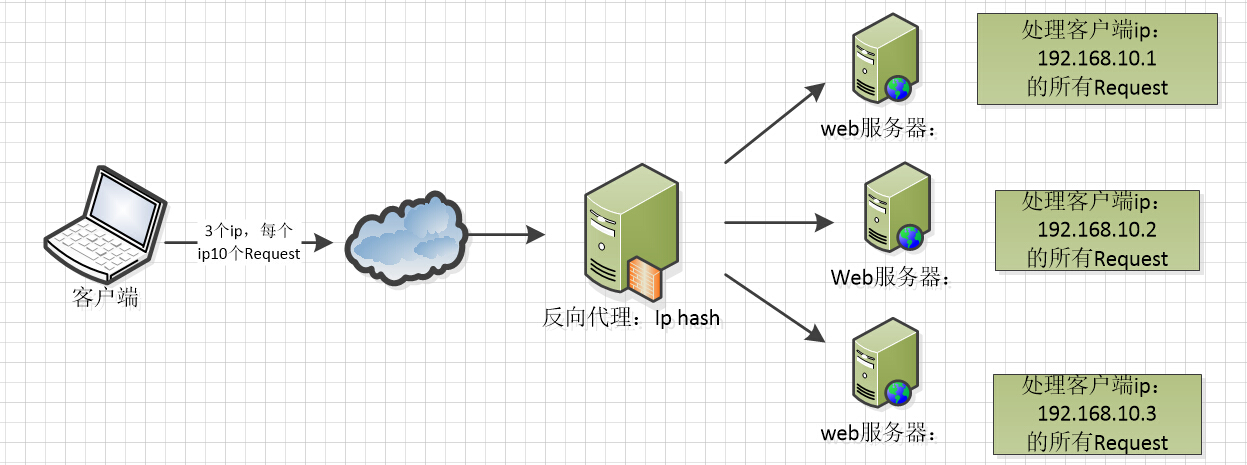## Nginx 配置
来源:互联网 发布:深圳市网络诈骗 编辑:程序博客网 时间:2024/06/06 01:43
Nginx 配置
Nginx (“engine x”) 是一个高性能的HTTP和反向代理服务器,也是一个IMAP/POP3/SMTP服务器。Nginx是一款轻量级的Web 服务器/反向代理服务器及电子邮件(IMAP/POP3)代理服务器,并在一个BSD-like 协议下发行的。
1.准备工作
# yum install -y pcre pcre-devel # yum install -y zlib zlib-devel # yum install -y openssl openssl-devel 2.下载并安装
# mkdir nginx-src && cd nginx-src # wget http://nginx.org/download/nginx-1.7.3.tar.gz # tar xzf nginx-1.7.3.tar.gz # cd nginx-1.7.3 # ./configure # make # make install # whereis nginx nginx: /usr/local/nginx 跳转至安装路径,查看安装版本
# ./nginx -h 启动
nginx停止
nginx -s stop3.Nginx常用功能 摘抄自张书豪
1.Http代理,反向代理 
Nginx在做反向代理时,提供性能稳定,并且能够提供配置灵活的转发功能。Nginx可以根据不同的正则匹配,采取不同的转发策略,比如图片文件结尾的走文件服务器,动态页面走web服务器,只要你正则写的没问题,又有相对应的服务器解决方案,你就可以随心所欲的玩。并且Nginx对返回结果进行错误页跳转,异常判断等。如果被分发的服务器存在异常,他可以将请求重新转发给另外一台服务器,然后自动去除异常服务器。
2.负载均衡
Nginx提供的负载均衡策略有2种:内置策略和扩展策略。内置策略为轮询,加权轮询,Ip hash。扩展策略,就天马行空 
Ip hash算法,对客户端请求的ip进行hash操作,然后根据hash结果将同一个客户端ip的请求分发给同一台服务器进行处理,可以解决session不共享的问题。 
3.web缓存
ginx可以对不同的文件做不同的缓存处理,配置灵活,并且支持FastCGI_Cache,主要用于对FastCGI的动态程序进行缓存。配合着第三方的ngx_cache_purge,对制定的URL缓存内容可以的进行增删管理。
4.Nginx 配置文件结构
apache的配置文件,它的相对比较清晰和简单,之前觉得很难,现在沉下心来想想,其实很简单。大致的分块下,基本就分为以下几块:
mainevents { ....}http { .... upstream myproject { ..... } server { .... location { .... } } server { .... location { .... } } ....}nginx配置文件主要分为六个区域:
main(全局设置)、events(nginx工作模式)、http(http设置)、
sever(主机设置)、location(URL匹配)、upstream(负载均衡服务器设置)。
下面粘贴一张真实用例。
#user nobody;worker_processes 1;error_log logs/error.log;error_log logs/error.log notice;error_log logs/error.log info;#pid logs/nginx.pid;events { worker_connections 1024;}http { include mime.types; default_type application/octet-stream; #log_format main '$remote_addr - $remote_user [$time_local] "$request" ' # '$status $body_bytes_sent "$http_referer" ' # '"$http_user_agent" "$http_x_forwarded_for"'; #access_log logs/access.log main; sendfile on; #tcp_nopush on; #keepalive_timeout 0; keepalive_timeout 65; #gzip on; server { listen 80; server_name alan.com; #charset koi8-r; # access_log logs/host.access.log main; location / { root html; index index.html index.htm; location = /hello.html { index hello.html; } location /rtis-ois { proxy_set_header Accept-Encoding 'gzip'; proxy_set_header Access-Control-Allow-Origin '*'; proxy_pass http://localhost:8080/RTIS-OIS-0.0.1; } location /diocm-viewer { proxy_set_header Accept-Encoding 'gzip'; proxy_set_header Access-Control-Allow-Origin '*'; proxy_pass http://139.217.25.228:8080/dicom-viewer; } #error_page 404 /404.html; # redirect server error pages to the static page /50x.html # error_page 500 502 503 504 /50x.html; location = /50x.html { root html; } # proxy the PHP scripts to Apache listening on 127.0.0.1:80 # #location ~ \.php$ { # proxy_pass http://127.0.0.1; #} # pass the PHP scripts to FastCGI server listening on 127.0.0.1:9000 # #location ~ \.php$ { # root html; # fastcgi_pass 127.0.0.1:9000; # fastcgi_index index.php; # fastcgi_param SCRIPT_FILENAME /scripts$fastcgi_script_name; # include fastcgi_params; #} # deny access to .htaccess files, if Apache's document root # concurs with nginx's one # #location ~ /\.ht { # deny all; #} } # another virtual host using mix of IP-, name-, and port-based configuration # #server { #listen 8081; # listen 127.0.0.1:8080; #server_name a.alan.com; #access_log /usr/local/nginx/a.alan.com.log main; #root /usr/data/a.alan.com # location / { # root html; # index index.html index.htm; # } #} # HTTPS server # #server { # listen 443 ssl; # server_name localhost; # ssl_certificate cert.pem; # ssl_certificate_key cert.key; # ssl_session_cache shared:SSL:1m; # ssl_session_timeout 5m; # ssl_ciphers HIGH:!aNULL:!MD5; # ssl_prefer_server_ciphers on; # location / { # root html; # index index.html index.htm; # } }}- Varnish+Nginx 配置----Nginx
- Nginx-配置-nginx.conf
- 【Nginx】Nginx配置优化
- 105 nginx nginx 配置
- nginx nginx.conf 配置
- nginx 配置
- nginx 配置
- Nginx配置
- nginx配置
- NGINX配置
- nginx配置
- Nginx配置
- nginx配置
- nginx配置
- nginx 配置
- nginx 配置
- nginx配置
- Nginx配置
- IP头,TCP头,UDP头,MAC帧头定义
- 可视化培训时变数据篇:当时间变化后,数据呈现的是这样的美图
- ZOJ 3964 Yet Another Game of Stones (博弈)
- 进阶篇_类型打包专家tuple
- 刷leetcode 经历与总结
- ## Nginx 配置
- 正则
- SurfaceView小例子
- 第二行代码学习笔记——第五章:全局大喇叭——详解广播机制
- 模块化开发
- 设备树学习之(三)Clock
- HDFS文件写入与读取
- 从零开始 React Native (4) React入门_状态属性_生命周期
- NYOJ257郁闷的C小加(一)_中缀转后缀


